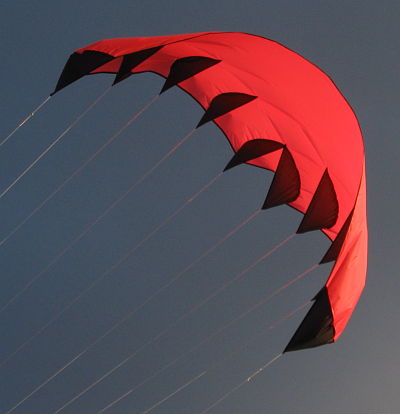
Rata is an acronym for "rib angled to airflow". Constructing a kite using ratas has synergistic effects:
- The upper rib curve creates an airfoil shape in the canopy.
- The entire rib functions as a load curtain, dispersing bridle forces from lower rib point into the canopy. The canopy does not distort under increasing load as it would with attaching the bridle directly to the canopy.
- Prevents nose/LE collapse by creating a high pressure area under the LE. Angling the rib so that it is not aligned with air flow slows the fluid, causing this high pressure area.
- Enhance L/D by creating multiple vorticies under wing, instead of only at tips. It is known that several tips on a wing or sail can be much more efficient than a single tip. See Performance Analysis of a Wing with Multiple Winglets for example. I am optimistically guessing that the rata wing also benefits from this. :-)
- Outward moment of ribs directs airflow under kite, resulting in a better projected area to flat area ratio (kite is more 'open' or 'flat').
Articles Lift to Drag Ratio and FoilNose 2 describe why preventing nose collapse is key to improving L/D. Rata is superior to nose anti-collapse alternatives in that:
- Ram air tube sections are heavier and do not spread bridle point loads.
- Ram air foil sections are heavier and more difficult to sew.
- Rod sections are heavier, more difficult to transport, and less scalable.
- Bladders (LEIs) are heavier and require more setup time.
Implementation
This rata design is implemented as a supported leading edge (SLE) style kite as this serves to minimize bridle lines. However, rata can also be used on more traditional traction kites which use mid canopy bridle points. Rata's can take the place of some or all of those bridle points.Separate from the rata invention is how rata is implemented on this kite: foldout ribs. A foldout rib is a specially designed rib which is sewn to the canopy while the rib is lying flat on the canopy. The foldout rib technique can be applied to other style kites, dual skin foils, etc., not just single skin kites.
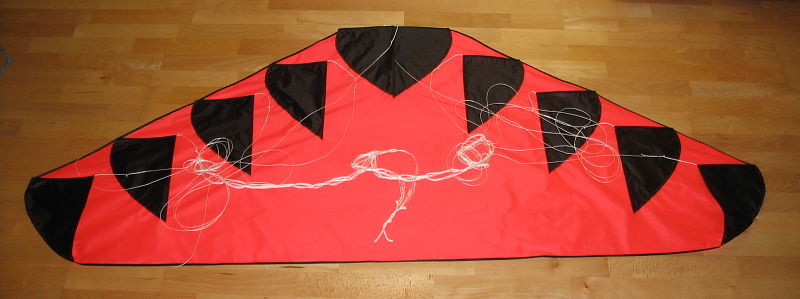
The picture above shows the foldout ribs lying flat on the surface of the kite. Compare this with the combined shape of the rib and canopy in pictures of the kite in flight below where the nose of the kite is facing the camera.
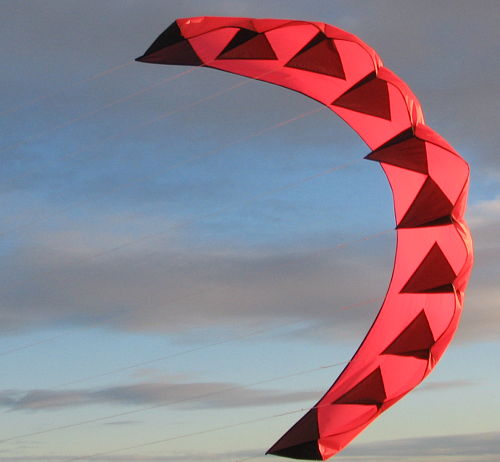
Making ribs with using the foldout rib technique is dead simple: sew two flat pieces of fabric together. 3D shape appears when part is in flying position! Also, packing the kite is easy, it collapses to flat sheets of fabric which fold down nicely.
So, rata can be implemented without foldout ribs and foldout ribs can be used in other kite styles.
Proof of Concept
The rata wing kite shown on this page was flown on the last day of 2007 at Amager Strand in Copenhagen, Denmark. Map location: 55°39'31"N 12°38'26"E.The next two pictures show the back of the kite while in flight. The rib to canopy connection can be seen outlined by the valleys in the fabric. The rib to canopy join is at an angle to the wind flow. Since the load is spread across this entire connection point, the valley is not as deep as it would have been with a bridle line connected directly to the canopy. The design of the rib determines the curvature of the canopy at the rib canopy intersection.
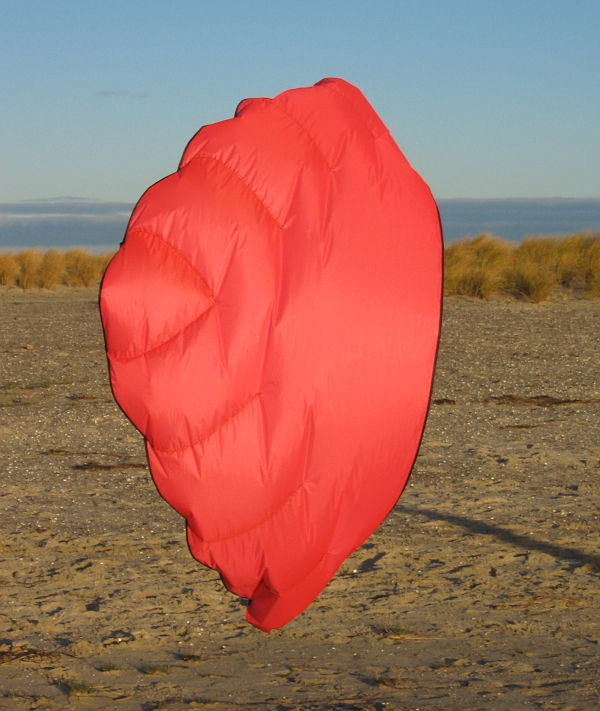
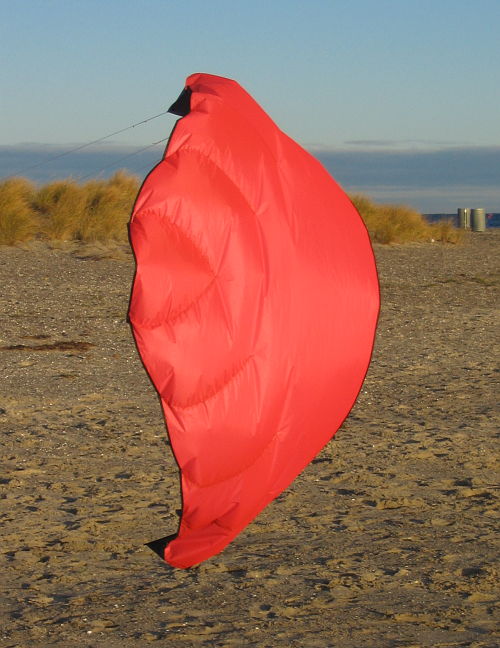
Below is a front view of the rata wing in flight. The tension on the bridles unfolds the ribs from the canopy and produces a fully three dimensional shape. Like the canopy, the ribs themselves get an airfoil shape in this process. Air flowing along the bottom surface of the kite creates a 'lift' force in the ribs towards the tips of the kite, making the canopy flatter and more open. In this process, "a favorable pressure field" is created at the nose and leading edge, preventing the entire front of the kite from collapsing.
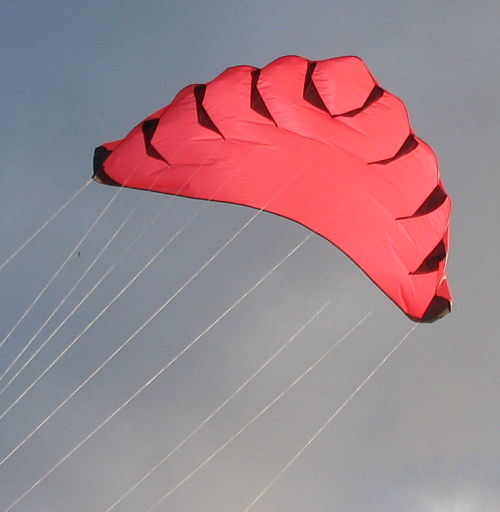
Below is a rear view of the rata wing in flight. This picture better shows the three dimensional shape of the ribs. The trailing edge of the kite is quite open, more flat than 'C' shaped.
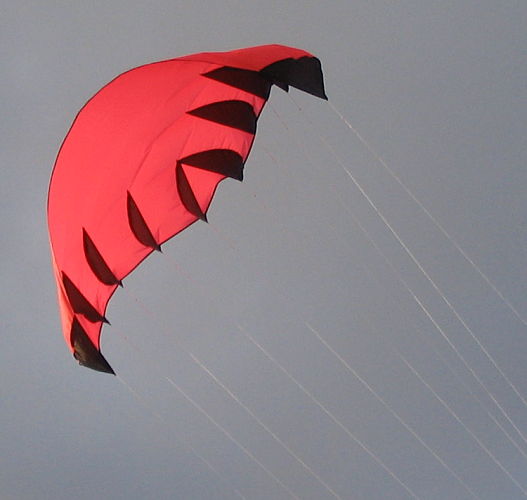
Bridle tuning was done with the same jig as NPWC v8. All bridle lines exit the tuning jig at a single location. The kite was steered by pulling on one of the two lines tied to the top of the dog stake (which then lead to the tips of the kite).
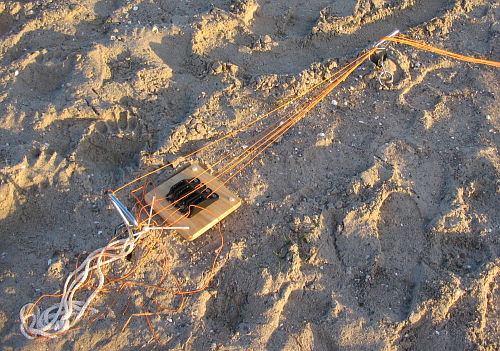
Side note: the Sanskrit definition of "Rata" is "That which is given or offered." Interesting.
This prototype passed the 'ease of relaunch' test. Half way through tuning the bridles, my launch assistant and photographer decided they would rather play on the beach and collect rocks and shells. From that point onward I had to tune bridle settings and take photograph while letting the kite take care of itself. This kite does not auto-zenith, and wandered to both sides of the window bouncing off the ground as the wind rose and fell. Several times it would be collapsed on the ground, only to relaunch by itself when a stronger gust of wind hit.
Wind speed: 4.5-6.5 m/s. Temperature: 5° Celsius.
Improvements
This kite surprised me with its performance, being the first prototype of a kite using rata construction. I am used to my crazy ideas flopping on the ground for the first few iterations before finally deciding to reward me with flight. The most pressing improvement would be skin shape towards the tips. The rata ribs in this prototype all had the same curvature. I can see that this design would benefit from a little more curvature at the nose and much less (canopy to rib connection) curvature at the tips.
Related pages:
Rata Jet the next iteration
Lift to Drag Ratio